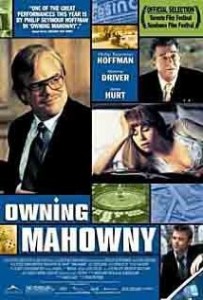 “I don’t have a gambling problem. I have a financial problem.”
“I don’t have a gambling problem. I have a financial problem.”
The fourth movie in our Gambling in the Movies series was Owning Mahowny. The film was released in 2003 and was one of the first lead roles for the late Philip Seymour Hoffman, playing Dan Mahowny. Set in the 1980s, the film recreates the real-life events of Brian Molony, a banker who was ultimately convicted of embezzling money from a Canadian bank, to fund his escalating gambling addiction. The film is often cited as the most accurate movie portrayal of problem gambling (see a personal account in the BASIS). So, after covering the glitz of gambling in ‘21’, we approached this movie with great interest.
The opening scene shows Dan in therapy after his gambling spiral and arrest, and in so doing, the early scenes immediately place his story in the context of a mental illness. We then join Dan’s story mid-way through the development of his disorder. We do not learn anything about the precipitating factors, his family background or upbringing. Instead the audience watches as Dan engages in various different forms of gambling including blackjack, roulette, sports betting and race track betting.
Dan’s emerging behaviors are clearly consistent with the modern DSM-5 diagnosis of Gambling Disorder. He is completely preoccupied with gambling; at all points of the film he is either gambling, or generating funds for gambling by siphoning money from his clients’ investment accounts. Pointedly, we do not see Dan engage in any other pleasurable behaviors in the film; this ‘narrowing of the reward repertoire’ is very characteristic of addictions. We see an escalation in the size of his betting, such that his final binge in Atlantic city exceeds $1m dollars. He shows clear withdrawal features when he tries to stop gambling, getting enraged with a friend who enforces his own instructions to keep hold of some winnings. Dan lies about the extent of his losses and is secretive about his weekend excursions. He also continues to gamble as his relationship, job, and ultimately his freedom become threatened.
Despite this detailed clinical picture of the objective signs of excessive gambling, the film is largely silent on Dan’s inner motives and mental states during gambling. Gamblers typically display a range of faulty beliefs and cognitive distortions that contribute to their persistent play. Gambling also serves to induce or alter emotions; either excitement, or the distraction from distressing emotions. It is difficult to determine if Dan is experiencing these features. He refers to breaking his streaks. He also loses track of time, seemingly being immersed in the game to the extent that he is forced to leave the casino at closing time, having forgotten to even eat dinner. In a late scene, he seems to experience some dissociation, hallucinating himself in the audience, watching the craps game unfold. Ultimately, these strands are unresolved and their importance in his downfall is unclear.
The film is perhaps most insightful in describing the ‘stages of change’. Dan spends the majority of the film in the ‘pre-contemplation stage’, as exemplified by his assertion that “I don’t have a gambling problem. I have a financial problem.” After two separate confrontations over his gambling with his partner, Dan only progresses to the contemplation stage after his arrest. Of the external forces that help Dan maintain this façade, the most notable is the casino management, who are quick to seize upon his potential for revenue, and ‘comp’ Dan to penthouse suites and other exotic services.
In this regard, Owning Mahowny is a necessary counterpoint to the glamorous, sexy casino environment depicted in 21. It is also clear that Dan is highly intelligent — he is mathematically astute and a promising banker — and yet these abilities do not enable him to build a profit from gambling. As the plot slowly unravels so does Dan’s work and relationship life.
Our average rating for Owning Mahowny:
Accurate portrayal of Gambling: 4.5/5
Enjoyableness: 3/5